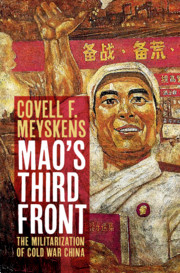Book contents
- Mao’s Third Front
- Mao’s Third Front
- Copyright page
- Contents
- Tables
- Figures
- Maps
- Abbreviations
- Acknowledgements
- Introduction
- 1 The Coming of the Third Front Campaign
- 2 Good People and Good Horses Go to the Third Front
- 3 Concentrating Forces to Wage Wars of Annihilation
- 4 Produce First and Consume Later
- 5 Industrial Development amid Cold War Insecurity
- Epilogue: The Demilitarization of Chinese Socialism
- Appendix: Third Front Demographics
- Bibliography
- Index
5 - Industrial Development amid Cold War Insecurity
Published online by Cambridge University Press: 24 April 2020
- Mao’s Third Front
- Mao’s Third Front
- Copyright page
- Contents
- Tables
- Figures
- Maps
- Abbreviations
- Acknowledgements
- Introduction
- 1 The Coming of the Third Front Campaign
- 2 Good People and Good Horses Go to the Third Front
- 3 Concentrating Forces to Wage Wars of Annihilation
- 4 Produce First and Consume Later
- 5 Industrial Development amid Cold War Insecurity
- Epilogue: The Demilitarization of Chinese Socialism
- Appendix: Third Front Demographics
- Bibliography
- Index
Summary
Chapter 5 assesses the CCP’s efforts to industrialize China during the Third Front campaign. I demonstrate that the Third Front constrained development by dedicating economic resources to costly projects in the interior instead of focusing on less expensive coastal endeavors. The Cultural Revolution also elevated construction costs by hindering the completion of projects. The Third Front, however, was the sole economic policy that Party leaders formulated at the time to develop inland areas, and despite its many problems, it helped to lessen regional economic differences. The industrialization of inland China in turn provided a foundation for post-Mao economic growth by accelerating the movement of regional resources, linking the interior more tightly into national networks, and fostering the CCP’s aspiration to industrialize whole regions.
Keywords
- Type
- Chapter
- Information
- Mao's Third FrontThe Militarization of Cold War China, pp. 201 - 226Publisher: Cambridge University PressPrint publication year: 2020

